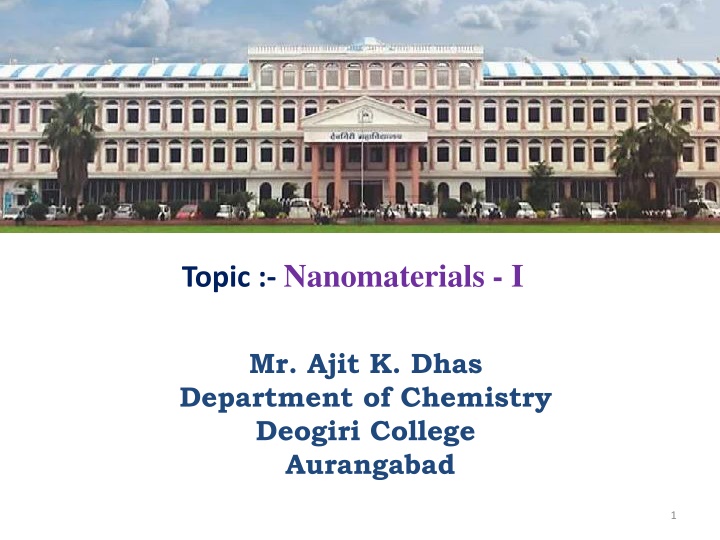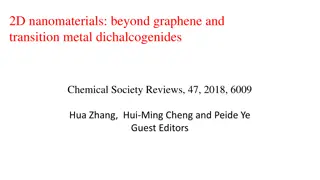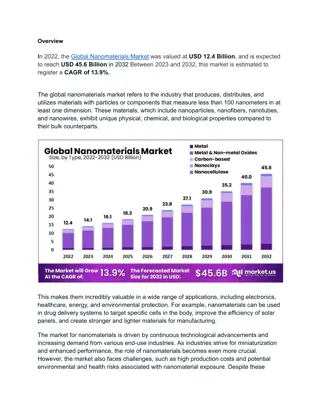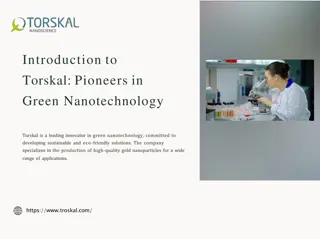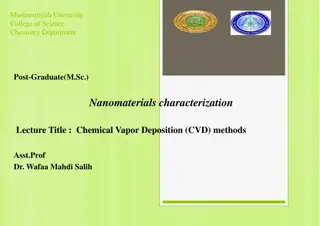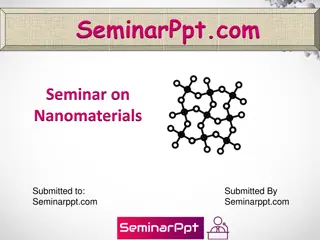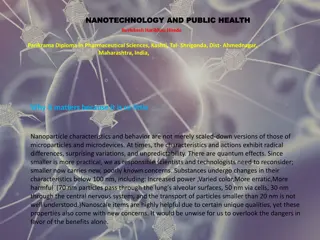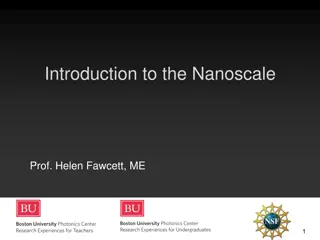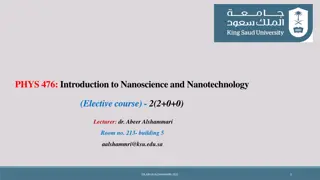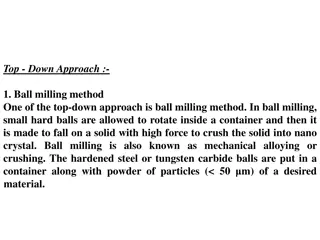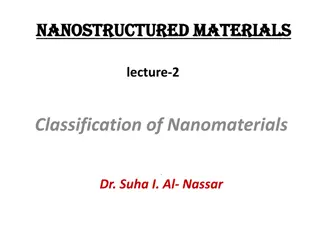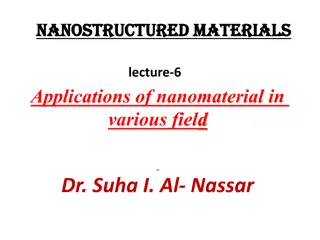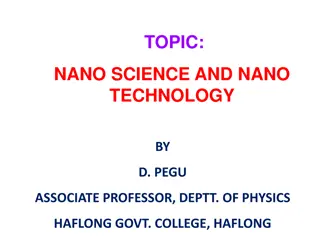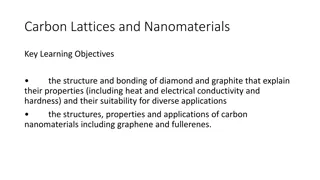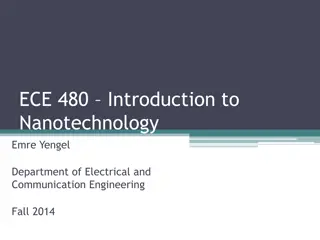Introduction to Nanomaterials and Nanotechnology
The term "nano" originates from the Greek word "nanos," meaning small. Nanoscience and nanotechnology deal with very tiny objects, leading to unique properties and applications in various fields. When bulk materials are transformed into nanomaterials, their properties undergo significant changes, impacting mechanical, electrical, and magnetic characteristics. Nanoparticles at the nano scale exhibit properties distinct from their bulk counterparts, emphasizing the importance of understanding and utilizing nanoscale materials effectively. The significance of nanotechnology dates back to Richard Feynman's groundbreaking lecture in 1959, highlighting the immense potential for innovation at the nanoscale level.
Download Presentation

Please find below an Image/Link to download the presentation.
The content on the website is provided AS IS for your information and personal use only. It may not be sold, licensed, or shared on other websites without obtaining consent from the author.If you encounter any issues during the download, it is possible that the publisher has removed the file from their server.
You are allowed to download the files provided on this website for personal or commercial use, subject to the condition that they are used lawfully. All files are the property of their respective owners.
The content on the website is provided AS IS for your information and personal use only. It may not be sold, licensed, or shared on other websites without obtaining consent from the author.
E N D
Presentation Transcript
Topic :- Nanomaterials - I Mr. Ajit K. Dhas Department of Chemistry Deogiri College Aurangabad 1
B. Sc. III (V Semester) Nanomaterials - I
Nanomaterials Contents: Introduction to nano-materials Application of nanomaterials
Introduction The term nano originated from the Greek nanos which means small . It is onebillionth of a meter. Therefore, whenever we think about nanoscience ornanotechnology, very small objects come to the mind.
Introduction When bulk materials are converted into nanomaterials it s properties like mechanical, electrical, magnetic and other physical properties such as colour, solubility, melting point etc. may changes. E.g. Bulk gold particles are yellow in colour & they don t have any catalytic property while it s nanoparticles are red in colour & they shows good catalytic property.
Nano Scale Particle in the size range of 1 nm to 100 nm (10-9 to 10-7 m) Each nanometer is only three to five atoms wide. 1 nano meter = 10- 9 meter or 10- 7 centimeter 10 nm = 10-10 meter = 1 (angstrom )
Father of Nanotechnology Richard Feynman Nobel Laureate in Physics, 1965, credited for introducing the concept of nanotechnology about 50 years ago. In the annual meeting of the American Physical Society at California Institute of Technology on 26 December 1959, he delivered a famous lecture entitled There s Plenty ofRoom at the Bottom .
Nanotechnology is not new! Father of Nanotechnology. Nobel Laureate in Physics, 1965, credited for introducing the concept of nanotechnology about 50 years ago. In the annual meeting of the American Physical Society at California Institute of Technology on 26 December 1959, he delivered a famous lecture entitled There s Plenty ofRoom at the Bottom .
Important terms in Nanotechnology Nano particles: Particles having size 1 nm to 100 nm are called as nanoparticles Nano Science: Study of properties of the nano size materials. Nano materials: These are the materials having high potential & it can exit in different forms such as powder, coating, nanotubes, particles. It may be metal, Composite , Ceramics etc. Nanotechnology: Study of synthesis and application of Nanomaterials.
Types of nanomaterials. Sr. No. Non-intentionally made Nanomaterials (Naturally occurring) These are the nanomaterials that occur naturally in the environment. Intentionally made Nanomaterials (Engineered Nanomaterials) 1 These are the nanomaterials prepare by some special man made processes. 2 e.g. DNA, RNA, Viruses, volcanic ash, etc. e.g. Commercially available products such as diesel smoke, cooking smoke, intentionally made & commercially available cosmetic, electronic, composite, sports items etc.
Advantages of nano materials Advantages: 1. Nanomaterials are more reactive then their bulk counterpart. 2. Nanomaterials are more energy efficient. 3. Nanomaterials are lighter. 4. Nanomaterials shows different properties than it s bulk counterparts.
Disadvantages of nano materials Disadvantages: 1. Very less information is available on toxic effect of nanomaterials. 2. Nanomaterials are likely to have more toxic effect if they get contaminated in soil, air or water resources.
What makes Nano Particles special? The properties of the matter is depend on it s size. The properties of the matter at nano size is different than its bulk size counterpart. Various properties such as solubility, colour, optical and electrical properties of the matter changes drastically at nano level. One of the reason for the change in properties is very high increase in surface area to volume ratio of nanoparticles than the bulk size particles.
Applications of Nano materials Catalyst: Nano catalyst are more effective than its regular size catalyst. Energy source: Nanomaterials (nano catalyst) are use in solar cell for the decomposition of H2O to produce hydrogen as a fuel. Water Purification: Specially made nanoparticles are use to prepare filters, membranes and adsorbents useful in water purification. Quantum Dots: The semiconductors nanomaterials having different colures depending on particle size are called quantum dots & they are used in production of television, mobile display units.
Applications of Nano materials Automobile: Nano particles are developed to improve the mechanical strength of the tires. Nano catalyst are use to reduce the pollutant present in automobile exhaust. Textile: Nano materials are used in the preparation of stain resistant cloths. Medicine: Silver nano particles show antibacterial property. Nanotechnology is also used in targeted drug delivery. Cosmetics: ZnO and TiO2 nano particles are in sun screen lotions to protect skin from harmful UV radiations.
